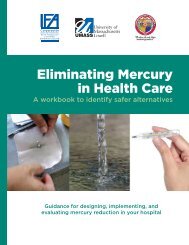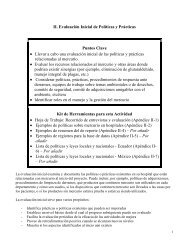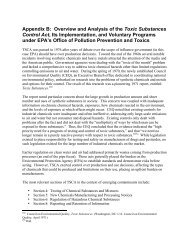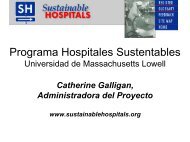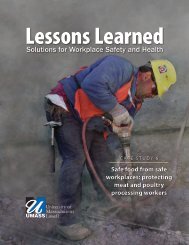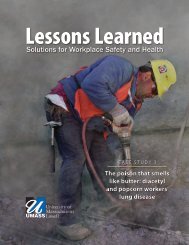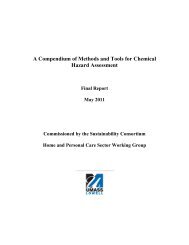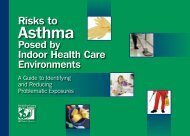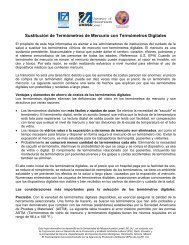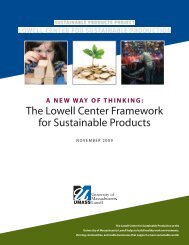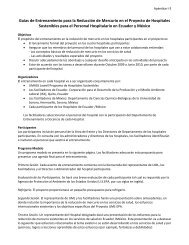Agriculture and Cancer - Lowell Center for Sustainable Production
Agriculture and Cancer - Lowell Center for Sustainable Production
Agriculture and Cancer - Lowell Center for Sustainable Production
You also want an ePaper? Increase the reach of your titles
YUMPU automatically turns print PDFs into web optimized ePapers that Google loves.
<strong>Agriculture</strong> <strong>and</strong> <strong>Cancer</strong><br />
a need<br />
<strong>for</strong><br />
action
<strong>Agriculture</strong> <strong>and</strong> <strong>Cancer</strong><br />
What Do We Know?<br />
Well designed <strong>and</strong> resilient agricultural systems are<br />
essential <strong>for</strong> producing the food <strong>and</strong> fiber necessary<br />
<strong>for</strong> secure, prosperous <strong>and</strong> healthy communities. Yet<br />
farming is one of the most dangerous industries in<br />
the United States, according to the Bureau of Labor<br />
Statistics. 1 Illnesses, acute injuries <strong>and</strong> even<br />
fatalities are high among agricultural workers compared<br />
to other industries due to the use of machinery<br />
<strong>and</strong> equipment, repetitive physical work, close<br />
interactions with animals, <strong>and</strong> exposure to chemical<br />
toxicants. 2,3<br />
Overall cancer incidence <strong>and</strong> mortality rates are<br />
low among farmers relative to the general population.<br />
4 However, studies of farming populations routinely<br />
reveal elevated risk <strong>for</strong> several specific types<br />
of cancer, including leukemia, non-Hodgkin’s lymphomas,<br />
multiple myeloma, soft-tissue sarcoma, <strong>and</strong><br />
cancers of the skin, brain, prostate, stomach <strong>and</strong> lip. 4<br />
Researchers continue to explore whether there are<br />
a set of common exposures that may explain these<br />
higher incidence rates using epidemiologic studies.<br />
This work documents that a variety of substances either<br />
created by or used in agricultural practices may<br />
increase cancer risk, [see evidence side-bars] including:<br />
pesticides, nitrates in fertilizers, dusts, solvents,<br />
fuels, engine exhaust, paints <strong>and</strong> welding fumes. 4<br />
Although agricultural populations are exposed to a<br />
broad array of substances that have been linked to<br />
cancer, the bulk of the research to date has focused<br />
on pesticides.<br />
In 2001, an estimated 5 billion pounds of pesticides<br />
were used in the United States. 5 Of that, 1.2 billion<br />
pounds were used primarily in the agricultural<br />
<strong>and</strong> home <strong>and</strong> garden sectors. 5 Approximately 165<br />
currently registered pesticidal chemicals (including<br />
active <strong>and</strong> inert ingredients in pesticides) have been<br />
classified by the Environmental Protection Agency<br />
(EPA) or the International Agency <strong>for</strong> Research on<br />
<strong>Cancer</strong> (IARC) as known, probable or possible human<br />
carcinogens. 6 Yet only a small number of these chemicals<br />
have been severely restricted. 6<br />
Agricultural Exposures<br />
Not Just Workers<br />
<strong>Agriculture</strong> is one of the largest industrial sectors<br />
in the United States, with nearly 2 million full-time<br />
workers employed in agricultural production as of<br />
2007. 7 As noted above, these workers face many occupational<br />
exposures to pesticides <strong>and</strong> other industrial<br />
agents that may contribute to cancer risk. However,<br />
full-time adult agricultural workers are not the<br />
only people potentially exposed to these substances.<br />
<strong>Agriculture</strong> is one of the few industries in the U.S. in<br />
which families often share the work. Based on 2006<br />
statistics, 50% of farm-based children under age 20
per<strong>for</strong>m farm work <strong>and</strong> an additional 307,000 children<br />
<strong>and</strong> adolescents are hired to work. 7 Among pesticide<br />
applicator families in the National <strong>Cancer</strong> Institute’s<br />
Agricultural Health Study, 21% of homes are within<br />
50 yards of pesticide mixing areas; 27% of applicators<br />
store pesticides in their home; <strong>and</strong> 94% of clothing<br />
worn <strong>for</strong> pesticide work is washed in the same machine<br />
as other laundry. 8 Data from this study also<br />
reveal that 51% of male pesticide applicators’ wives<br />
worked on the farm during the last growing season;<br />
a significant number of wives (40%) reported mixing<br />
or applying pesticides themselves; <strong>and</strong> just under half<br />
(46%) have done so <strong>for</strong> more than 10 years. 8<br />
Pesticide levels in carpet dust are<br />
typically 10- to 200-fold higher<br />
than levels in air inside the home.<br />
Indirect environmental exposure is also a significant<br />
problem <strong>for</strong> people living near farms. For example,<br />
a recent study found that pregnant women<br />
living in an agricultural area had 2.5 times higher<br />
levels of organophosphate insecticide metabolites<br />
in their urine compared to the general US population.<br />
9 Twenty years ago, the US Department of <strong>Agriculture</strong><br />
estimated that 50 million people in the US<br />
obtain their drinking water from groundwater that is<br />
contaminated with pesticides <strong>and</strong> other agricultural<br />
chemicals such as nitrates from fertilizers. 10 Although<br />
such a survey needs updating, these data are in<strong>for</strong>mative<br />
<strong>for</strong> exploring existing patterns of cancer incidence.<br />
Studies also confirm that pesticides used<br />
in agricultural areas contaminate the air miles from<br />
where they are applied, <strong>and</strong> also show up in dust<br />
samples from inside people’s homes. 11,12 Pesticide levels<br />
in carpet dust are typically 10- to 200-fold higher<br />
than levels in air inside the home. 13 Pesticides are<br />
also found in the soil surrounding homes, although<br />
usually at lower levels than indoors because sun, water<br />
<strong>and</strong> soil microbes can degrade pesticides in soil<br />
over time. 13 Indoor pesticide exposure can be especially<br />
problematic <strong>for</strong> children <strong>and</strong> pets, since they<br />
spend more time on the floor <strong>and</strong> they explore the<br />
world by putting objects in their mouths.<br />
<strong>Cancer</strong><br />
A Disease Resulting from the Combined<br />
Effect of Multiple Risk Factors<br />
Many studies document increased risk of cancer<br />
among children <strong>and</strong> adults associated with exposure<br />
to an array of pesticides. 14-16 Yet regulatory actions<br />
to ban or severely restrict pesticide use based on<br />
evidence of carcinogenicity in humans are rare. One<br />
of the main reasons that regulatory bodies such as<br />
EPA <strong>and</strong> OSHA do not act on the current evidence<br />
base is the difficulty of quantifying human exposure
to specific pesticides <strong>and</strong> assessing associated health<br />
risks. Workers <strong>and</strong> the public are often exposed to<br />
several types of pesticides, as well as other carcinogenic<br />
substances such as tobacco smoke <strong>and</strong> diesel<br />
particulates. Thus, it is difficult to establish strong<br />
epidemiological evidence that exposure to a single,<br />
specific pesticide causes cancer or other health effects.<br />
In the absence of strong evidence that a pesticide<br />
causes harm, it remains in use.<br />
example, in the Agricultural Health Study, pesticide<br />
applicators exposed to the organophosphate pesticides<br />
phorate <strong>and</strong> fonofos had an elevated risk of<br />
prostate cancer, but only among those with a family<br />
history of the disease. 18,19 Higher nitrate levels in<br />
public water supplies were linked to nearly a two-fold<br />
excess risk of kidney cancer, but only in combination<br />
with consuming above the median amounts of red<br />
meat or below the median amounts of vitamin C. 20<br />
<strong>Cancer</strong> is not caused by a single factor. Rather, it results from<br />
a complex, multi-factorial, multi-stage process.<br />
Yet cancer is not caused by a single factor. Rather,<br />
it results from a complex, multi-factorial, multi-stage<br />
process. Researchers have identified at least six essential<br />
cellular alterations that must occur in order<br />
<strong>for</strong> cancer to develop. 17 Animal studies show that<br />
pesticides may increase the risk of cancer through a<br />
variety of mechanisms, including genotoxicity, tumor<br />
promotion, hormonal action <strong>and</strong> immunotoxicity. 14<br />
<strong>Cancer</strong> risk is also influenced by a variety of factors,<br />
including diet, genetic inheritance, reproductive factors,<br />
other lifestyle factors, <strong>and</strong> exposure to a variety<br />
of agents at work <strong>and</strong> in the general environment.<br />
Studies examining the links between pesticides<br />
<strong>and</strong> risk of prostate cancer have shown that genetics<br />
<strong>and</strong> pesticide exposure together influence risk. For<br />
Scientific evidence reveals that it is not only what<br />
a person is exposed to, but also the timing of the exposure<br />
that influences cancer risk. Exposure to toxicants<br />
during periods of rapid growth <strong>and</strong> cell differentiation—from<br />
fetal life through puberty—can be<br />
an important contributor to cancer risk later in life.<br />
Risks of childhood cancers are linked with parental<br />
exposures to pesticides prior to conception, in utero<br />
exposures <strong>and</strong> direct exposures during childhood. 16<br />
Some evidence indicates that children are at greatest<br />
risk if exposed to pesticides in utero. 21 A recent<br />
study demonstrates that girls exposed to elevated<br />
levels of DDT be<strong>for</strong>e puberty—when mammary cells<br />
are more susceptible to the carcinogenic effects of<br />
hormones, chemicals <strong>and</strong> radiation—are five times<br />
Strength of the evidence linking specific cancers with human exposure<br />
to agents in the agricultural environment 14-16,20,27,45–47<br />
Evidence<br />
Bladder<br />
Suspected: PAHs<br />
Breast Suspected: 2,4-D, chlordane, DDT/DDE, dieldrin, hexachlorobenzene, malathion,<br />
organic solvents, PAHs, triazine herbicides, farm wives living/presence near pesticideapplied<br />
crops<br />
Brain <strong>and</strong> other central nervous system Suspected: N-nitroso compounds (fertilizers),<br />
parental occupation/occupation associated with pesticide exposure<br />
Colorectal Suspected: alachlor, aldicarb, aldrin, chlorpyrifos, chlordane, dicamba, dieldrin,<br />
occupation associated with pesticide exposure<br />
Hodgkin’s Disease Suspected: chlorophenols, DDT/DDE, dioxin-contaminated phenoxy herbicides,<br />
occupation associated with pesticide exposure, solvents<br />
Kidney<br />
Suspected: N-nitroso compounds (fertilizers), parental occupation/occupation associated with pesticide exposure, solvents<br />
Leukemia Suspected: aldrin, carbon disulfide, chlordane, DDT/DDE, dieldrin, ethylene dibromide, heptachlor, lindane, mancozeb, methyl bromide,<br />
parental occupation/occupation associated with pesticide exposure, phosphine, simazine, toxaphene<br />
Lung Strong: air pollution, arsenic <strong>and</strong> arsenic compounds, diesel exhaust, wood dust Suspected: carbofuran, chlorpyrifos, DDT/DDE, diazinon,<br />
dicamba, dieldrin, metolachlor, occupation associated with pesticide exposure, pendimethalin, phenoxyherbicides <strong>and</strong>/or dioxin contaminants
more likely to develop breast cancer when they reach<br />
middle age. 22<br />
Risks of childhood cancers are linked<br />
with parental exposures to pesticides<br />
prior to conception, in utero exposures<br />
<strong>and</strong> direct exposures during childhood.<br />
Single cancer risk factors always act within multidimensional<br />
causal webs reflecting the cumulative<br />
interaction among risks across the life course. Moreover<br />
these risk factors interact at various levels of<br />
organization (biological, social, <strong>and</strong> ecological) <strong>and</strong><br />
scales (individual, family, community, society <strong>and</strong><br />
ecosystem). Preventing cancer will depend on addressing<br />
the broader set of conditions that influence<br />
risk in both our research <strong>and</strong> cancer prevention <strong>and</strong><br />
control programs.<br />
Under-Studied <strong>and</strong> Overexposed<br />
Migrant Workers Face Higher Risks<br />
It is estimated that 2.5 to five million individuals <strong>and</strong><br />
their families work as migrant <strong>and</strong> seasonal agricultural<br />
workers. 23 These workers provide crucial labor<br />
<strong>for</strong> much of crop production <strong>and</strong> processing in the<br />
US. 23 Due to working <strong>and</strong> housing conditions, farm<br />
workers often encounter disproportionate exposure<br />
to pesticides. Children of migrant workers often accompany<br />
their parents into the field due to lack of<br />
child care. 4<br />
The study of cancer among farm workers is an under-researched<br />
area given the difficulty of conducting<br />
long-term studies of a highly mobile population.<br />
Indeed, published studies may not be generalizable<br />
to the broader farm worker population, as successful<br />
studies depend on factors such as permanent or<br />
semi-permanent residence <strong>and</strong> the presence of community-based<br />
research programs. 24 Nevertheless, existing<br />
studies can be instructive. Several studies conducted<br />
among members of the United Farm Workers<br />
of America (UFW) in Cali<strong>for</strong>nia reveal increased risk<br />
of leukemia 25 as well as cancers of the stomach, liver<br />
<strong>and</strong> gallbladder, biliary passages <strong>and</strong> uterine cervix. 26<br />
Risk of breast cancer was also found to be elevated<br />
in a registry-based study of female farm labor union<br />
members in Cali<strong>for</strong>nia. 27 In this study, there was a<br />
six-fold elevation of breast cancer among those who<br />
worked with mushrooms. In addition, a number of<br />
pesticides were associated with elevated breast cancer<br />
risk, including chlordane, malathion, <strong>and</strong> 2,4-D. The<br />
association between pesticide exposure <strong>and</strong> breast<br />
cancer risk was stronger among younger women <strong>and</strong><br />
those with early-onset breast cancer. A more recent<br />
case control study of UFW members that examined
the risk of gastric (stomach) cancers found a near<br />
3-fold elevation in risk among workers in the citrus<br />
industry. 28 In this study, risk of stomach cancer was<br />
also elevated among those using 2,4-D, chlordane,<br />
propargite <strong>and</strong> trifluralin.<br />
Addressing the multidimensional causal web by<br />
which cancer develops in migrant <strong>and</strong> seasonal agricultural<br />
workers will require additional research on<br />
the multiple risk factors experienced by these workers.<br />
Intervention to prevent future cancers will also<br />
require a greater underst<strong>and</strong>ing of the broader social<br />
context that influences cancer risk.<br />
Don’t We Have Regulations to<br />
Protect Agricultural Workers?<br />
Both EPA <strong>and</strong> the Occupational Safety <strong>and</strong> Health<br />
Administration (OSHA) have regulations designed to<br />
safeguard agricultural workers. But these regulations<br />
are often ignored in the field <strong>and</strong> many are inadequate<br />
to protect migrant <strong>and</strong> seasonal agricultural workers<br />
from cancer risks related to pesticide exposures.<br />
OSHA regulates farm worker health <strong>and</strong> safety issues<br />
but not as they relate to pesticides. However,<br />
other provisions within the Occupational Safety <strong>and</strong><br />
Health Act influence cancer risk reduction measures,<br />
including the obligation to provide training <strong>and</strong> communications<br />
about hazards <strong>and</strong> to provide safe drinking<br />
water <strong>and</strong> field sanitation. Yet OSHA’s limited resources<br />
A serious cancer prevention agenda must<br />
ensure that policies <strong>and</strong> programs are in<br />
place to guarantee the safe <strong>and</strong> equitable<br />
working conditions necessary to prevent<br />
cancer <strong>and</strong> other diseases in workers.<br />
mean that it has a minimal capacity to inspect facilities<br />
subject to OSHA st<strong>and</strong>ards to ensure compliance.<br />
Within OSHA’s field sanitation provisions, regulations<br />
exempt agricultural operations with ten or fewer<br />
employees from providing drinking water, h<strong>and</strong>washing<br />
facilities <strong>and</strong> toilets <strong>for</strong> their employees, regardless<br />
of the conditions or hours required <strong>for</strong> their work<br />
in the fields. Even among farms required to comply<br />
with OSHA farm worker st<strong>and</strong>ards—farms with 10 or<br />
more workers—compliance is poor. A recent North<br />
Carolina survey found that only 4 percent of farmworkers<br />
surveyed had access to drinking water, h<strong>and</strong><br />
washing facilities, <strong>and</strong> toilets. 23 Lack of protective<br />
equipment <strong>and</strong> prompt access to showers <strong>and</strong> laundry<br />
facilities may exacerbate exposure to hazards like<br />
pesticides by prolonging contact with the skin. 4<br />
In 1992, EPA revised the Worker Protection St<strong>and</strong>ard<br />
(WPS) <strong>for</strong> agricultural pesticides. This regulation<br />
is designed to protect farm workers <strong>and</strong> requires<br />
pesticide safety training, notification of pesticide<br />
applications, use of personal protective equipment,<br />
Multiple myeloma Suspected: DDT/DDE, dioxin-contaminated phenoxyherbicides/chlorophenols,<br />
glyphosate, occupation associated with pesticide exposure, solvents<br />
Evidence<br />
(continued)<br />
Non-Hodgkin’s Lymphoma Strong: dioxin-contaminated phenoxyherbicides/chlorophenols<br />
Suspected: 2,4-D, carbamate, carbaryl, chlorophenols, dicamba, ethylene dibromide,<br />
glyphosate, hexachlorocyclohexane/lindane, MCPA, mecoprop, methyl bromide, organochlorine<br />
pesticides, occupation associated with pesticide exposure, phosphine, solvents<br />
Pancreatic<br />
Suspected: DDT/DDE, occupation associated with pesticide exposure<br />
Prostate Suspected: butylate, chlordane, chlorpyrifos, coumaphos, cyanazine, DDT/<br />
DDE, dioxin-contaminated phenoxyherbicides, fonofos, hexachlorobenzene, methyl bromide,<br />
occupation associated with pesticide exposure, permethrin, phorate<br />
Ovarian<br />
Suspected: atrazine, occupation associated with pesticide exposure<br />
Soft-tissue sarcoma<br />
occupation associated with pesticide exposure<br />
Suspected: chlorophenols, DDT/DDE, dioxin-contaminated phenoxyherbicides,<br />
Skin Strong: arsenic <strong>and</strong> arsenic compounds, PAHs Suspected: DDT/DDE, occupation associated with pesticide exposure<br />
Stomach Suspected: atrazine, agricultural work in the citrus industry, chlordane, occupation associated with pesticide exposure, propargite,<br />
<strong>and</strong> trifluralin<br />
Testicular<br />
Suspected: occupation associated with pesticide exposure
estricted entry intervals following pesticide application,<br />
decontamination supplies <strong>and</strong> emergency<br />
medical assistance. 29 Yet despite improvements in<br />
farm worker protection that have resulted from the<br />
WPS, there are major documented compliance failings.<br />
According to a recent study of migrant farm<br />
worker families residing along the Texas-Mexico border,<br />
only 46.1% of mothers participating in migrant<br />
farm work reported having received training in the<br />
safe use of pesticides within the previous five years<br />
as required by WPS. 30 Similar findings regarding the<br />
low penetration of pesticide safety training among<br />
farmer workers have been reported in other regions<br />
of the country as well. 31<br />
This evidence makes clear the need <strong>for</strong> continued<br />
ef<strong>for</strong>ts to eliminate exposure disparities among<br />
seasonal farm workers <strong>and</strong> their families. A serious<br />
cancer prevention agenda must ensure that policies<br />
<strong>and</strong> programs are in place to guarantee the safe <strong>and</strong><br />
equitable working conditions necessary to prevent<br />
cancer <strong>and</strong> other diseases in these workers.<br />
If Some Pesticides Contribute to<br />
<strong>Cancer</strong> or Other Serious Health<br />
Conditions, Why Aren’t They Banned?<br />
The Federal Insecticide, Fungicide <strong>and</strong> Rodenticide<br />
Act (FIFRA) gives EPA the authority to assess <strong>and</strong><br />
manage the risks of pesticides. Under FIFRA, industry<br />
is required to submit toxicity <strong>and</strong> environmental data<br />
to demonstrate evidence of safety when registering a<br />
pesticide. However, pesticide regulation is not based<br />
on a public health or safety st<strong>and</strong>ard. Rather, it is<br />
based on a risk-benefit st<strong>and</strong>ard. EPA registers a pesticide<br />
<strong>for</strong> use if it does not pose “unreasonable risk<br />
to man or the environment, taking into account the<br />
economic, social <strong>and</strong> environmental costs <strong>and</strong> benefits<br />
of the use of any pesticide.” 32<br />
Although EPA has banned or restricted dozens of<br />
pesticides, approval of a pesticide <strong>for</strong> registration by<br />
EPA is no assurance that it is safe, as demonstrated<br />
by the following examples.<br />
■■ Under FIFRA, new pesticides coming on the market<br />
(an average of 18 new pesticides a year) 33 can<br />
be used based on a “conditional registration” allowance,<br />
which allows use of the pesticide be<strong>for</strong>e<br />
complete health <strong>and</strong> safety testing are supplied<br />
to EPA. 34 A survey by the Northwest Coalition <strong>for</strong><br />
Alternatives to Pesticides (NCAP) found that of<br />
the 41 new conventional pesticides registered <strong>for</strong><br />
use between 1991 <strong>and</strong> 2001, over half were conditionally<br />
registered. 33<br />
■■ The active ingredient of the pesticide may not<br />
be the only source of exposure to cancer-causing<br />
agents. Yet toxicity testing <strong>for</strong> chronic diseases<br />
such as cancer is only required <strong>for</strong> the active<br />
ingredient of the pesticide, <strong>and</strong> only active
ingredients are required to be listed on the product<br />
label. 35 “Inert” ingredients may also be toxic,<br />
but they are not often listed on the label because<br />
the <strong>for</strong>mulation is protected as trade secret. For<br />
example, xylene is used as the inert ingredient in<br />
almost 900 pesticides. 32 Some evidence supports<br />
an increased risk of leukemia, brain <strong>and</strong> rectal<br />
cancers as well as a range of more acute effects<br />
such as neurological conditions <strong>and</strong> eye, throat<br />
<strong>and</strong> nose irritation associated with exposure to<br />
xylene. 33,36,37<br />
■■ As of this writing, data regarding the ability of<br />
pesticides to disrupt endocrine systems <strong>and</strong> contribute<br />
to a variety of disease outcomes have not<br />
been required <strong>for</strong> pesticides. Yet dozens of published<br />
studies report on the ability of a variety<br />
of pesticides to disrupt hormone signaling at extremely<br />
low levels of exposure <strong>and</strong> these disruptions<br />
may contribute to cancer development or<br />
progression. Although EPA has convened scientific<br />
panels to assist the Agency in determining testing<br />
procedures <strong>for</strong> endocrine disruption, <strong>and</strong> has proposed<br />
an initial list of pesticide active <strong>and</strong> inert<br />
ingredients to be considered <strong>for</strong> screening 38 , no<br />
pesticides registered to date have been reviewed<br />
in the context of the emerging literature regarding<br />
endocrine disrupting effects.<br />
■■ EPA relies heavily on data from pesticide manufacturers<br />
to assess <strong>and</strong> manage the risks of<br />
pesticides—in fact FIFRA requires that pesticide<br />
manufacturers provide data <strong>for</strong> registration. Yet<br />
an analysis of research conducted <strong>and</strong>/or funded<br />
by pesticide manufacturers versus government<br />
funded or academic research found important differences<br />
in research conclusions. 39 Studies funded<br />
by pesticide manufacturers are far more likely to<br />
report null findings regarding deleterious health<br />
outcomes associated with exposure to pesticides<br />
compared to studies funded by other sources—<br />
findings which keep specific pesticides on the<br />
market.<br />
■■ Both newly registered <strong>and</strong> re-reregistered pesticides<br />
can show evidence of cancer <strong>and</strong> still be<br />
used. For example, the fungicide vinclozolin is<br />
widely used on vineyards <strong>and</strong> was registered <strong>for</strong><br />
use in 2000, despite laboratory tests indicating<br />
that it causes testicular cancer <strong>and</strong> disrupts normal<br />
<strong>and</strong>rogen activity in laboratory animals. 40<br />
Recent animal studies demonstrate epigenetic<br />
effects such that rats exposed to high levels of<br />
vinclozolin while in utero developed tumors at<br />
a much higher frequency than non-exposed rats;<br />
the pattern held true <strong>for</strong> their offspring <strong>and</strong> their<br />
offspring’s offspring. 41 In fact, the subsequent<br />
generations with no direct exposure to the fungicide<br />
had a higher frequency of tumor development<br />
<strong>and</strong> a range of other diseases compared to those<br />
only exposed while in utero. Additional multi-
generational studies at levels routinely experienced<br />
by agricultural workers are needed. At the<br />
same time, these findings are sufficient to raise<br />
serous concerns about impacts to human health<br />
<strong>and</strong> warrant precautionary action related to use<br />
of such pesticides.<br />
■■ As in the case of the re-registration of phosmet,<br />
EPA regularly approves continued pesticide use<br />
despite known harm to farmworkers based on predictions<br />
about the effectiveness of new mitigation<br />
measures. 42 However, EPA has limited resources<br />
to confirm that the mitigation measures work as<br />
expected to reduce risks.<br />
We can no longer depend on a<br />
system of enumerating costs <strong>and</strong><br />
benefits that repeatedly fails to<br />
prevent cancer <strong>and</strong> other diseases<br />
associated with pesticide exposure.<br />
We need to revamp our pesticide registration procedures<br />
to protect the public’s health. We can no<br />
longer depend on a system of enumerating costs <strong>and</strong><br />
benefits that repeatedly fails to prevent cancer <strong>and</strong><br />
other diseases associated with pesticide exposure.<br />
There is an inherent flaw in a system which requires<br />
years of research <strong>and</strong> review <strong>for</strong> a single pesticide,<br />
when hundreds remain in use <strong>and</strong> inadequately regulated.<br />
Incentives to adopt safer pesticide alternatives<br />
are needed, including broader adoption of integrated<br />
pest management <strong>and</strong> organic agriculture<br />
practices.<br />
Are Pesticides in Food a Major<br />
Source of Exposure to Carcinogens?<br />
Under the Food Quality Protection Act (FQPA) of 1996,<br />
EPA began reassessing food tolerances <strong>for</strong> concentrations<br />
of pesticides or their breakdown products that<br />
are allowed to remain in or on food, using a new<br />
set of st<strong>and</strong>ards that are more protective of public<br />
health.<br />
EPA sets tolerance levels <strong>for</strong> food at a level such<br />
that a person’s combined exposure to a given pesticide<br />
from different sources (such as food, drinking water,<br />
<strong>and</strong> home use of pesticides) <strong>and</strong> applied according to<br />
label instructions <strong>and</strong> harvesting guidelines is 100 to<br />
1,000 times lower than “no observable effect level”<br />
(NOEL) or the dose at which no adverse effects were<br />
observed in toxicity studies. This includes a safety<br />
factor to account <strong>for</strong> the susceptibility of children.<br />
If a pesticide causes cancer in experimental animal<br />
studies, then EPA adjusts use guidelines so exposure<br />
will be less than the amount calculated to cause one<br />
extra case of cancer per million people. 43
Although FQPA is an important step <strong>for</strong>ward in<br />
protecting the health of the public from pesticide<br />
residues, it has significant limitations:<br />
■■ The procedures still do not account <strong>for</strong> the fact<br />
that individuals are exposed to multiple pesticide<br />
residues <strong>and</strong> other chemicals that may influence<br />
cancer risk.<br />
FQPA is an important step in safeguarding the<br />
public from exposure to pesticides that may present a<br />
cancer risk at low levels of exposure <strong>and</strong> during critical<br />
windows of vulnerability. It provides us with key<br />
lessons about how science-based regulatory decisions<br />
can better prevent cancer <strong>and</strong> other significant health<br />
conditions by addressing the complexities of disease<br />
causation. However, vigilance is needed to ensure<br />
There is a need <strong>for</strong> a new generation of policy approaches that move beyond regulations<br />
that simply address the risk of one pesticide at a time or one agent at a time.<br />
■■ In its food tolerance reassessments, EPA has routinely<br />
discarded the tenfold safety factor requirement<br />
intended to protect infants <strong>and</strong> children.<br />
The law requires EPA to use this safety factor if<br />
the toxicology data indicate that children will be<br />
more susceptible to adverse effects than adults, or<br />
if there are data gaps. Yet even when data clearly<br />
show that young animals are more susceptible to<br />
the effects of a pesticide than adult animals, EPA<br />
has failed to include the child safety factor. This<br />
was the case, <strong>for</strong> example, in EPA’s tolerance reassessment<br />
<strong>for</strong> endosulfan. 44<br />
that the law is implemented as intended. Moreover,<br />
there is a need <strong>for</strong> a new generation of policy approaches<br />
that move beyond regulations that simply<br />
address the risk of one pesticide at time or one agent<br />
at a time. Most of us are exposed to a complex array<br />
of agents that may increase cancer risk not only in<br />
the food we eat, but also in the air we breathe <strong>and</strong><br />
the materials we encounter in daily life. If we are<br />
serious about preventing cancer, we need a broad,<br />
concerted plan.
How Can We Prevent <strong>Cancer</strong> Linked<br />
to Agricultural Exposures?<br />
A comprehensive US cancer prevention agenda that promotes health, prevents cancer<br />
<strong>and</strong> protects the most vulnerable members of society will need to safeguard<br />
the people who grow <strong>and</strong> harvest the nation’s food <strong>and</strong> others exposed to harmful<br />
substances used in agriculture. Here are five ways we can prevent cancer linked to<br />
agricultural exposures:<br />
Support cancer research that captures the complexities of cancer causation,<br />
including multiple exposures, low-dose effects <strong>and</strong> critical windows of<br />
vulnerability.<br />
Eliminate disparities in permitted exposures associated with agricultural<br />
work <strong>and</strong> increased risk of cancer, especially among seasonal <strong>and</strong> migrant farm<br />
workers.<br />
Revamp our pesticide regulatory system to avoid introducing pesticides that<br />
increase cancer risk among workers <strong>and</strong> the general public. Phase out pesticides<br />
that show evidence of harm.<br />
Require EPA to consider non-pesticidal alternatives when considering pesticide<br />
registration applications.<br />
Identify safer alternatives to harmful pesticides <strong>and</strong> provide economic incentives<br />
<strong>for</strong> least-toxic agricultural production. Through policy <strong>and</strong> market-based<br />
ef<strong>for</strong>ts, stimulate adoption of effective integrated pest management <strong>and</strong> organic<br />
agriculture practices.<br />
Acknowledge that while scientific certainty is seldom possible, from our duty<br />
to inquire flows an obligation to take preventive action when sufficient evidence<br />
of harm exists.
REFERENCES<br />
1. US Department of Labor, Bureau of Labor Statistics. <strong>Agriculture</strong>, Forestry <strong>and</strong><br />
Fishing. Available at: http://www.bls.gov/oco/cg/pdf/cgs001.pdf.Accessed<br />
January 18, 2007.<br />
2. US Department of Labor, Bureau of Labor Statistics. National Census of Fatal<br />
Occupational Injuries in 2007. Available at: http://www.bls.gov/news.release/<br />
pdf/cfoi.pdf. Accessed September 12, 2008.<br />
3. US Department of Labor, Bureau of Labor Statistics. Table 1: Incidence Rates<br />
of Nonfatal Occupational Injuries <strong>and</strong> Illnesses by Selected Industries <strong>and</strong><br />
Case Types, 2006. Available at: http://www.bls.gov/news.release/osh.t01.htm.<br />
Accessed September 12, 2008.<br />
4. Blair A <strong>and</strong> Zahm SH. Agricultural Exposures <strong>and</strong> <strong>Cancer</strong>, Environmental<br />
Health Perspectives. 1995; 103(Suppl 8): 205–208.<br />
5. Kiely T, David D, Grube AH. Pesticide Industry Sales <strong>and</strong> Usage: 2000 <strong>and</strong> 2001<br />
Market Estimates. Report No. 733-R-04-011. Table 3.3, page 10. Available at:<br />
http://www.epa.gov/oppbead1/pestsales/01pestsales/market_estimates2001.<br />
pdf. Accessed October 8, 2008.<br />
6. Goldman LR. Chemicals <strong>and</strong> Children’s Environment: What We Don’t Know<br />
about Risks, Environmental Health Perspectives. 1998; 106(Suppl 3):875–880.<br />
7. NIOSH. NIOSH Safety <strong>and</strong> Health Topic: Agricultural Safety. Available at: http://<br />
www.cdc.gov/niosh/topics/aginjury/. Accessed September 12, 2008.<br />
8. Gladen BC, S<strong>and</strong>ler DP, Zahm SH, et al. Exposure Opportunities of Families<br />
of Farmer Pesticide Applicator, American Journal of Industrial Medicine.<br />
1998;34(6): 581–587.<br />
9. Bradman A, Eskenazi B, Barr DB, et al. Organophosphate Urinary Metabolite<br />
Levels during Pregnancy <strong>and</strong> After Delivery in Women Living in an Agricultural<br />
Community, Environmental Health Perspectives. 2005;113(12):1802–1807.<br />
10. Nielson EG, Lee LK. The Magnitude <strong>and</strong> Costs of Groundwater Contamination<br />
from Agricultural Chemicals: a National Perspective. Agricultural Economics<br />
Report# 576. Washington: US Department of <strong>Agriculture</strong>; 1987.<br />
11. Harnly M, McLaughlin R, Bradman A, et al. Correlating Agricultural Use of<br />
Organophosphates with Outdoor Air Concentrations: A Particular Concern <strong>for</strong><br />
Children, Environmental Health Perspectives. 2005;113(9):1184–1189.<br />
12. Lu C, Fenske RA, Simcox NJ, et al. Pesticide Exposure of Children<br />
in an Agricultural Community: Evidence of Household Proximity to<br />
Farml<strong>and</strong> <strong>and</strong> Take Home Exposure Pathways, Environmental Research.<br />
2000:84(3):290–302.<br />
13. Lewis RG, Fortmann RC, Camann DE. Evaluation of Methods <strong>for</strong> Monitoring<br />
the Potential Exposure of Small Children to Pesticides in the Residential<br />
Environment, Archives of Environmental Contamination <strong>and</strong> Toxicology.<br />
1994;26(1): 37–46.<br />
14. Dich Jan, Zahm SH, Hanberg A, et al. Pesticides <strong>and</strong> cancer, <strong>Cancer</strong> Causes<br />
<strong>and</strong> Control. 1997;8:420–443.<br />
15. Alavanja MCR, Ward MH, Reynolds P. Carcinogenicity of Agricultural Pesticides<br />
in Adults <strong>and</strong> Children, Journal of Agromedicine. 2007; 12(1):39–56<br />
16. Zahm SH, Ward MH. Pesticides <strong>and</strong> Childhood <strong>Cancer</strong>, Environmental Health<br />
Perspectives. 1998; 106(Suppl 3):893–908.<br />
17. Weinberg RA. The Biology of <strong>Cancer</strong>. New York, NY: Garl<strong>and</strong> Science, 2007.<br />
18. Mahajan R, Bonner MR, Hoppin JA, et al. Phorate Exposure <strong>and</strong> Incidence of<br />
<strong>Cancer</strong> in the Agricultural Health Study, Environmental Health Perspectives.<br />
2006;114(8): 1205–1209.<br />
19. Mahajan R, Blair A, Lynch CF, et al. Fonofos Exposures <strong>and</strong> <strong>Cancer</strong> Incidence<br />
in the Agricultural Health Study, Environmental Health Perspectives. 2006;<br />
114(2): 1838–1842.<br />
20. Ward MH, Rusiecki JA, Lynch CF, et al. Nitrate in Public Water Supplies <strong>and</strong> the<br />
Risk of Renal Cell Carcinoma, <strong>Cancer</strong> Causes & Control. 2007; 18(10): 1141–1151.<br />
21. Ma X, Buffler PA, Gunier RB, et al. Critical Windows of Exposure to Household<br />
Pesticides <strong>and</strong> Risk of Childhood Leukemia, Environmental Health<br />
Perspectives. 2002;110(9): 955–960.<br />
22. Cohn, BA, Wolfe MS, Cirillo PM, et al. DDT <strong>and</strong> breast cancer in young women:<br />
new data on the significance of age at exposure, Environmental Health<br />
Perspectives. 2007;115:1406–1414.<br />
23. National <strong>Center</strong> <strong>for</strong> Farm worker Health. Overview of America’s Farm Workers.<br />
Available at: http://www.ncfh.org/aaf_01.php. Accessed September 20, 2008<br />
24. Zahm SH, Blair A. Assessing the Feasibility of Epidemiologic Research on<br />
Migrant <strong>and</strong> Seasonal Farm Workers: an Overview, American Journal of<br />
Industrial Medicine. 2001;40(5):487–489.<br />
25. Mills PK, Yang R, Riordan D. Lymphohematopoietic <strong>Cancer</strong>s in the United Farm<br />
Workers of America (UFW), 1988–2001, <strong>Cancer</strong> Causes <strong>and</strong> Control. 2005;<br />
16:823–830.<br />
26. Mills PK, Beaumont JJ, Nasseri K. Proportionate Mortality among Current <strong>and</strong><br />
Former Members of the United Farm Workers of America, AFL-CIO, in Cali<strong>for</strong>nia<br />
1973–2000, Journal of Agromedicine. 2006;11(1):39–48.<br />
27. Mills PK, Yang R. Breast <strong>Cancer</strong> Risk in Hispanic Agricultural Workers in<br />
Cali<strong>for</strong>nia, International Journal of Occupational <strong>and</strong> Environmental Health.<br />
2005; 11(2): 123–131.<br />
28. Mills PK, Yang RC. Agricultural exposures <strong>and</strong> gastric cancer risk in Hispanic<br />
farm workers in Cali<strong>for</strong>nia, Environmental Research. 2007;104(2):282–289.<br />
29. U.S. Environmental Protection Agency. Pesticides Health & Safety, Worker<br />
Safety <strong>and</strong> Health. Available at: http://epa.gov/opp00001/health/worker.htm.<br />
Accessed September 20, 2008.<br />
30. Shipp EM, Cooper SP, Burau KD, et al. Pesticide Safety Training <strong>and</strong> Access to<br />
Field Sanitation among Migrant Farmworker Mothers from Starr County, Texas,<br />
Journal of Agricultural Safety <strong>and</strong> Health. 2005; 11(1): 51–60.<br />
31. Arcury TA, Qu<strong>and</strong>t SA, Austin CK, et al. Implementation of EPA’s Worker<br />
Protection St<strong>and</strong>ard Training <strong>for</strong> Agricultural Laborers: an Evaluation Using<br />
North Carolina Data. Public Health Reports. 1999; 114(5) :459–468.<br />
32. FIFRA Sec. 2 (bb).<br />
33. Cox C. Pesticide Registration No Guarantee of Safety. Northwest Coalition <strong>for</strong><br />
Alternatives to Pesticides. Available at: http://www.pesticide.org/EPARegis.<br />
pdf. Accessed September 19, 2008.<br />
34. FIFRA Sec 3(c)(7).<br />
35. U.S. Environmental Protection Agency. Inert Ingredients in Pesticide Products;<br />
Policy Statement. Federal Register 52(77):13305. April 22, 1987.<br />
36. Lynge E, Anttila A, Hemminki K. Organic Solvents <strong>and</strong> <strong>Cancer</strong>. <strong>Cancer</strong> Causes &<br />
Control 1997;8:406–19.<br />
37. ATSDR Toxicological Profile <strong>for</strong> Xylene. Agency <strong>for</strong> Toxic Substances <strong>and</strong> Disease<br />
Registry, <strong>Center</strong>s <strong>for</strong> Disease Control <strong>and</strong> Prevention, Atlanta, GA. August, 2007.<br />
38. Draft List of Initial Pesticide Active Ingredients <strong>and</strong> Pesticide Inerts to be<br />
Considered <strong>for</strong> Screening under the Federal Food, Drug, <strong>and</strong> Cosmetic Act.<br />
Federal Register 72(116):33486. June 19, 2007.<br />
39. McDaniel PA, Solomon G, Malon RE. The Tobacco Industry <strong>and</strong> Pesticide<br />
Regulation: Case Studies from Tobacco Industry Archives, Environmental<br />
Health Perspectives. 2005;113:1659–1665.<br />
40. U.S. Environmental Protection Agency. Pesticides <strong>and</strong> Toxic Substances.<br />
Reregistration Eligibility Decision (RED): Vinclozolin. Washington DC. 2000.<br />
41. Anway MD, Leathers C <strong>and</strong> Skinner MK. Endocrine Disruptor Vinclozolin<br />
Induced Epigenetic Transgenerational Adult Onset Disease, Endocrinology.<br />
2006; 147(12): 5515–5523.<br />
42. U.S. Environmental Protection Agency. Pesticides Registration, Phosmet IRED<br />
Facts (October 31, 2001). Available at: http://www.epa.gov/oppsrrd1/REDs/<br />
factsheets/phosmet_fs.htm. Accessed October 17, 2008.<br />
43. U.S. EPA. 1996 Food Quality Protection Act: Implementation Plan. March 1997,<br />
Washington DC. Available at: http://www.epa.gov/pesticides/regulating/laws/<br />
fqpa/impplan.pdf. Accessed October 14, 2008.<br />
44. Reaves E, Health Effects Division, Environmental Protection Agency. Memo<br />
to Tracy Perry, Special Review <strong>and</strong> Reregistration Division, Environmental<br />
Protection Agency. April 2, 2007.<br />
45. Clapp RC, Jacobs MM, Loechler EL. Environmental <strong>and</strong> Occupational Causes of<br />
<strong>Cancer</strong>: New Evidence 2005–2007, Reviews on Environmental Health. 23(1):<br />
1–36.<br />
46. Bassil KL, Vakil C, Sanborn M, et al. <strong>Cancer</strong> Health Effects of Pesticides:<br />
Systemic Review. Canadian Family Physician. 2007;53:1704–1711.<br />
47. Brody JG, Moysich KB, Humblet O. Environmental Pollutants <strong>and</strong> Breast<br />
<strong>Cancer</strong>: Epidemiologic Studies. <strong>Cancer</strong>. 2007; 109(Suppl 12): 2667–2711.<br />
This booklet was written by Molly Jacobs (<strong>Lowell</strong> <strong>Center</strong> <strong>for</strong> <strong>Sustainable</strong> <strong>Production</strong> at the University of Massachusetts, <strong>Lowell</strong>) <strong>and</strong> Dick Clapp (Boston University School of Public Health &<br />
<strong>Lowell</strong> <strong>Center</strong> <strong>for</strong> <strong>Sustainable</strong> <strong>Production</strong>). Editorial assistance was provided by Shelby Gonzalez (Commonweal). Analysis <strong>for</strong> the section of this booklet related to FIFRA <strong>and</strong> FQPA was in<strong>for</strong>med<br />
by communications with Aaron Colangelo at the National Resource Defense Council <strong>and</strong> the Northwest Coalition <strong>for</strong> Alternatives to Pesticide’s article, “Pesticide Registration No Guarantee of<br />
Safety” edited by Carolyn Cox. The content of this booklet is also the result of research, discussions <strong>and</strong> thoughtful scientific review through the Collaborative on Health <strong>and</strong> the Environment’s<br />
(CHE) <strong>Cancer</strong> Working Group. Specific contributors from CHE’s <strong>Cancer</strong> Working Group include: Ted Schettler (Science <strong>and</strong> Environmental Health Network), Charlotte Brody, Michael Lerner, <strong>and</strong><br />
Eleni Sotos (Commonweal), Jeanne Rizzo <strong>and</strong> Brynn Taylor (Breast <strong>Cancer</strong> Fund), Marion Kavanaugh-Lynch (University of Cali<strong>for</strong>nia), <strong>and</strong> Steve Helig (San Francisco Medical Society). We thank<br />
Susan Kegley at Pesticide Action Network North America <strong>for</strong> her expert review of this booklet. Design by John Svatek, half-full design. October 2008<br />
Additional copies of this booklet can be downloaded at www.health<strong>and</strong>environment.org <strong>and</strong> www.sustainableproduction.org.



